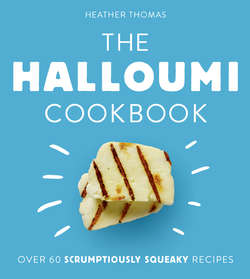Читать книгу The Halloumi Cookbook - Heather Thomas - Страница 8
ОглавлениеINTRODUCTION
In recent years, halloumi has become one of the most popular cheeses in the world. What makes it so special is its high melting point, and is sometimes simply referred to as ‘grilling cheese’. Unlike other cheeses, it is really versatile and can be grilled (broiled), griddled, barbecued, fried, roasted or baked without melting or losing its shape. Crisp and appetizingly golden brown on the outside, yet tender inside, it has a firm, and ‘meaty’, albeit slightly rubbery and ‘squeaky’, texture. Together with its salty, tangy, umami flavour, this makes it different from any other cheese, as does its ability to keep well in the fridge for up to a year if it’s left sealed in brine in its original packaging.
HISTORY AND ORIGINS
Although a recent phenomenon for many, halloumi isn’t new – it’s been around for centuries. The name is derived from the medieval Egyptian Arabic halom and in Turkey it’s still known as hellim. It originated over 1,000 years ago in Cyprus where it was a valuable source of protein for poor agrarian communities living off the land. Each village had its own special recipe and this semi-hard, unripened white cheese was made communally from sheep’s milk. As time passed, goat’s milk was sometimes added too, and some modern versions are even made with cow’s milk, although purists frown on this practice.
Mint was usually added for flavour, and the cheese keeps better when it is wrapped in fresh mint leaves. The halloumi most of us buy tends to be younger and milder than the dry, salty unpasteurised varieties that are still eaten in Cyprus where it is aged in brine for much longer to intensify the taste.
NUTRITION
Halloumi is rich in protein, vitamin A and calcium. Although, like other cheeses, it is relatively high in fat you can buy reduced-fat versions with 40 per cent less fat. And because most halloumi is made with goat’s or sheep’s milk it’s much lower in lactose than cow’s milk cheeses and can often be tolerated by people with mild lactose intolerance. It is higher in salt than most cheeses (330mg sodium per 25g/1oz), so if you’re on a low-sodium diet for health reasons, it would be wise to limit your consumption and to eat it in smaller quantities.
COOKING WITH HALLOUMI
Halloumi is widely eaten throughout Greece, Turkey and the Levant as a meze (a selection of small dishes served with drinks or at the start of a meal) or for breakfast, usually with hummus or falafels, or watermelon, olives and freshly baked bread in the hot summer months. In Cyprus, the Greek islands and mainland Greece it is used (pan-seared or fried) to make saganaki or served in salads and with grilled vegetables or lountza, a spiced smoked pork sausage. Its distinctive saltiness is a good counterpoint to the sweetness of watermelon, melon, figs and citrus fruits.
The recipes in this book include the latest trends as well as classic dishes from the eastern Mediterranean: Cyprus, Greece, Turkey, Lebanon, Syria, Egypt and Israel. Many are augmented with Middle Eastern flavourings and spices, such as preserved lemons, pomegranate molasses, sumac and za’atar. In addition, we have new and innovative recipes for halloumi sliders, ‘fries’, ‘fingers’, ‘bites’, burgers and fritters. It’s so versatile that it can be cooked over hot coals on a barbecue, griddled as a base for bruschetta, baked in pies or used as a topping for pizza. There are toasties, wraps and sandwiches plus great ideas for breakfast and brunch. We even have a vegetarian recipe for crisp battered halloumi ‘fish and chips’.
Whereas many of the recipes are vegetarian – often incorporating healthy grains, pulses and pasta – chicken, meat and fish are also featured. We even have a special section dedicated to baking with halloumi with recipes for delicious loaves, savoury scones and cheesy muffins. This is the ultimate cookbook for everyone who loves halloumi and wants to eat a really nutritious and healthy diet.
